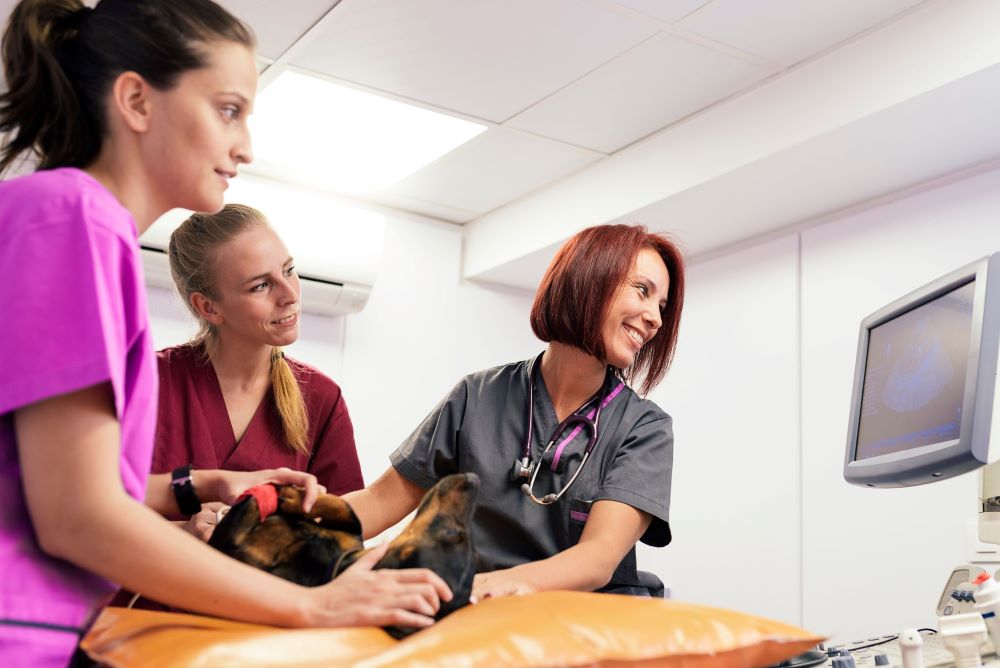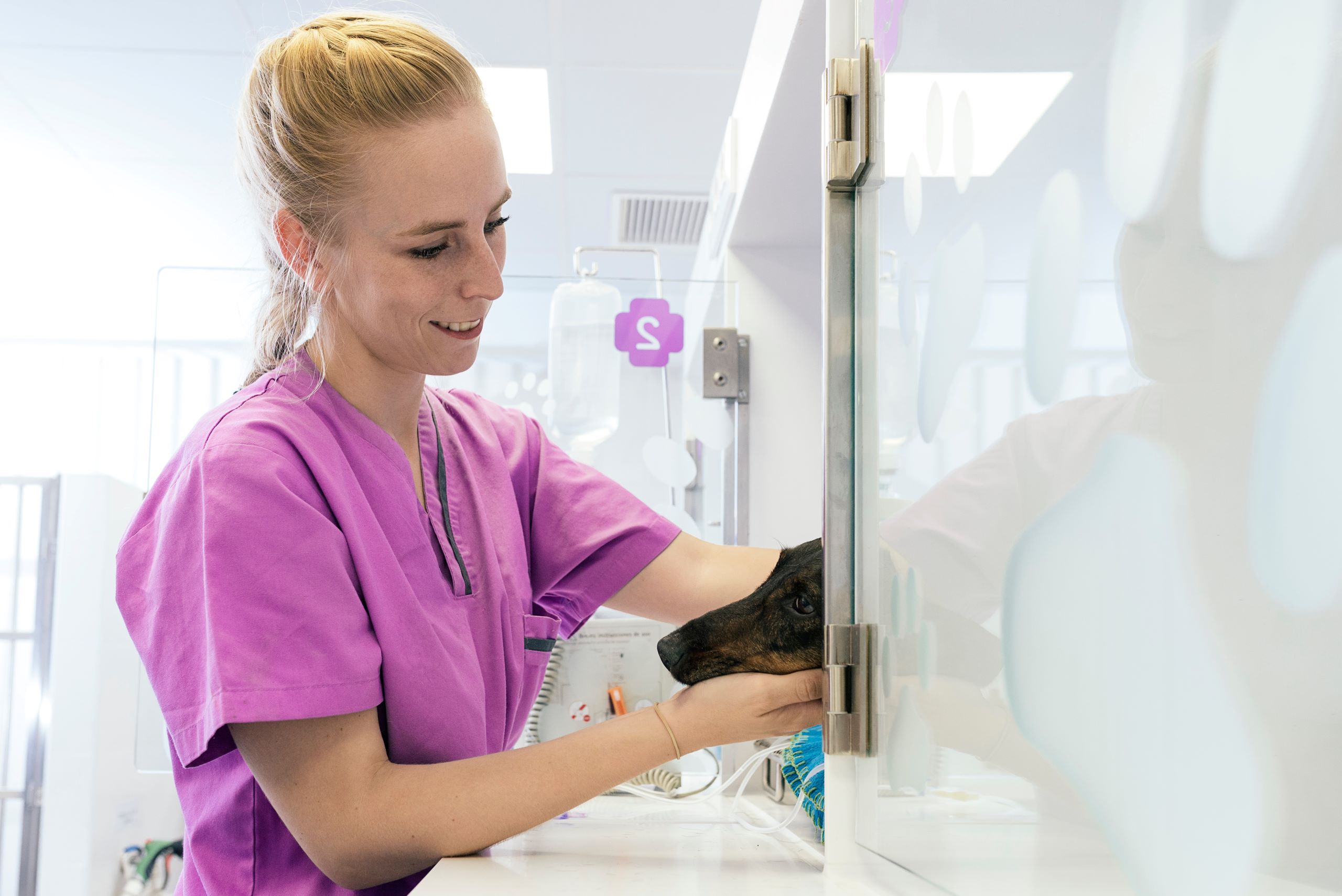Finding a work placement is an essential part of your animal care or veterinary nursing studies. This is where you’ll get to put your theory into practice, working with real animals and their owners in a clinical setting.
Depending on which qualification you’re completing, you’ll spend 200-280 hours (28-39 days) at your vet nurse work placement, so it’s best to find somewhere you feel comfortable.
What should I look for in a vet nurse work placement?
Here are our top tips for finding the right work placement for you:
1. Choose a placement that meets your training requirements
You’ll be given a training and assessment plan which outlines the tasks you need to complete while on work placement. This should give you a good idea of the type of place you’re looking for.
Working at a zoo or aquarium might be super interesting, but if your training plan asks you to demonstrate you’ve worked with domestic dogs and cats while on placement, they might not be the best choice.
Generally, we recommend a local veterinary clinic that sees a range of animal clients.
2. Consider mixing and matching your placements to get broader experience
You’ll do three separate work placement blocks throughout your studies, and there’s nothing stopping you from doing each of these placements with a different clinic.
For example, you could do your first two placements with your local vet, but then get some experience with some native animals at a wildlife hospital for your final placement. So long as each placement can provide you with the experience required to meet your training and assessment plan, you’re set.
3. The best workplace placement is the one you can confidently get to
No matter how amazing a veterinary clinic may seem, if it’s on the other side of town and you don’t have a reliable way of getting there each day, then it’s not the right one for you.
Practical things to consider when selecting a clinic for placement might include:
- If you’re driving each day, is there suitable parking nearby?
- Is there a public transport option that runs during your required work hours?
- Can you afford to travel to that clinic each day during your placement? (Consider petrol, parking fees and/or the cost of ride-shares or public transport each day.)
How do I apply for a veterinary work placement?
OK, so you’ve found a clinic (or three!) that you’re interested in. The next step is contacting them and asking if they would be willing to take you on for your work placement.
Asking to complete a work placement is like applying for any other job. You should:
- prepare your resumé and cover letter and email them to the clinic
- Google yourself to make sure you’re well-presented online
- practise responses to common interview questions (e.g. What are your greatest strengths?)
- read your training and assessment plan so you can answer any questions the clinics may have about the placement
- make sure you know how many hours are in each placement block.
We have templates you can download from aXcelerate, which you can modify and use to contact clinics.
You should log each clinic you contact in your workplace tracker (also located on aXcelerate). This will help you record who you’ve approached, whether you think they are a good fit and what their response was to your enquiry.
If you have trouble finding a placement and need placement assistance, you’ll need to have completed the workplace tracker as evidence that you’ve attempted to contact at least 10 clinics yourself.
Try not to get discouraged if some of the clinics you contact say no or don’t get back to you. They may already have a student completing their placement with them or perhaps they don’t have enough staff to take on a student right now.
My preferred clinic said 'yes' what do I do now?
Congratulations! Once a clinic has said they’re happy for you to do your work placement with them, you can start filling out the paperwork to lock everything in. You should complete a:
1. Workplace Approval Request Form
You’ll need to complete this form with the person who will be supervising you at the clinic.
When you submit this form in aXcelerate, be sure to include a copy of your supervisor’s qualifications.
We’ll then contact the clinic you’ve chosen and confirm if they're suitable. If a clinic is unable to support you with all the tasks listed in your Workplace Approval Request Form, you’ll need to:
- find a second clinic which will be able to support these tasks,
- find a different clinic which can support all tasks, or
- attend the optional residential workshop training blocks at Gatton to supplement any training gaps.
Your clinic and UQ will enter a formal agreement for placement insurance coverage. As an unpaid student on work placement, you’re covered by personal accident and legal liability insurance while you are inside the workplace. You’re not covered for pre-existing conditions.
Students that are already employed at a clinic and complete placement with their employer are covered by their employer’s insurance.
2. Clinical Placement Application Form
You’ll complete this form with your clinic supervisor closer to the start of your work placement block. It will state your exact placement attendance dates and hours of work.
Both you and your supervisor need to sign this form as it is a formal agreement for insurance purposes. If your attendance dates change in any way, the form must be amended and submitted BEFORE you attend any further dates. If you amend your block dates without notifying UQ Skills, you may not be covered under our insurance.
Once this form is received and approved, you and your supervisor will receive a confirmation email with the times/hours that you are able to attend placement.
How do I prepare for my first day on a work placement?
Starting a new work placement may feel a little daunting, but there are steps you can take to make sure you’re prepared for success:
1. Check that your mandatory vaccinations are up-to-date
As you'll be exposed to animals as part of your learning, immunisation against tetanus is mandatory.
You may also require vaccination against Q fever, lyssavirus, rabies or influenza (flu), depending on the work and environment within which you interact with animals.
If you haven’t already had them, make sure you allow enough time (at least 6 weeks) to get these prior to your placement.
For more information, visit UQ’s student immunisation requirements.
2. Find out what you’re required to wear
When you’re on your placement you’re representing your host clinic so it’s important that you look neat and tidy.
Each clinic is different, so it’s best to ask what your clinic’s expectations are. Some may want you to wear scrubs, but if they’re happy for you to wear regular clothes we'd recommend:
- black pants/jeans (no holes)
- a clean, ironed, presentable plain shirt
- closed-in shoes (mandatory).
It’s also common for clinics to request no facial piercings and no (or minimal) jewellery due to risk of injury (e.g. cleaning cages with rings).
3. Pre-plan your meals
Have a plan for your lunch and any snacks you may need throughout the day, whether that means you bring something from home or research places near your clinic where you can buy food.
4. Save important contact details
Make sure to have a contact number for your clinic supervisor and the UQ Skills office. Attendance and punctuality are important – let the clinic and UQ Skills know if you’re sick and can’t attend your work placement.
Other resources
There are three quizzes available on our aXcelerate site that are not mandatory but can help you prepare for attending placement:
- eProfessionalism
- Social Media
- Employability.
Your training and assessment plan will be sent to you via email. It’s your responsibility to print this out prior to your placement commencement date.
The training and assessment plan will outline all tasks you need to demonstrate during your placement block. Each day you will need to document your start and finish times and request that your supervisor signs off on your work at the end of each day.


